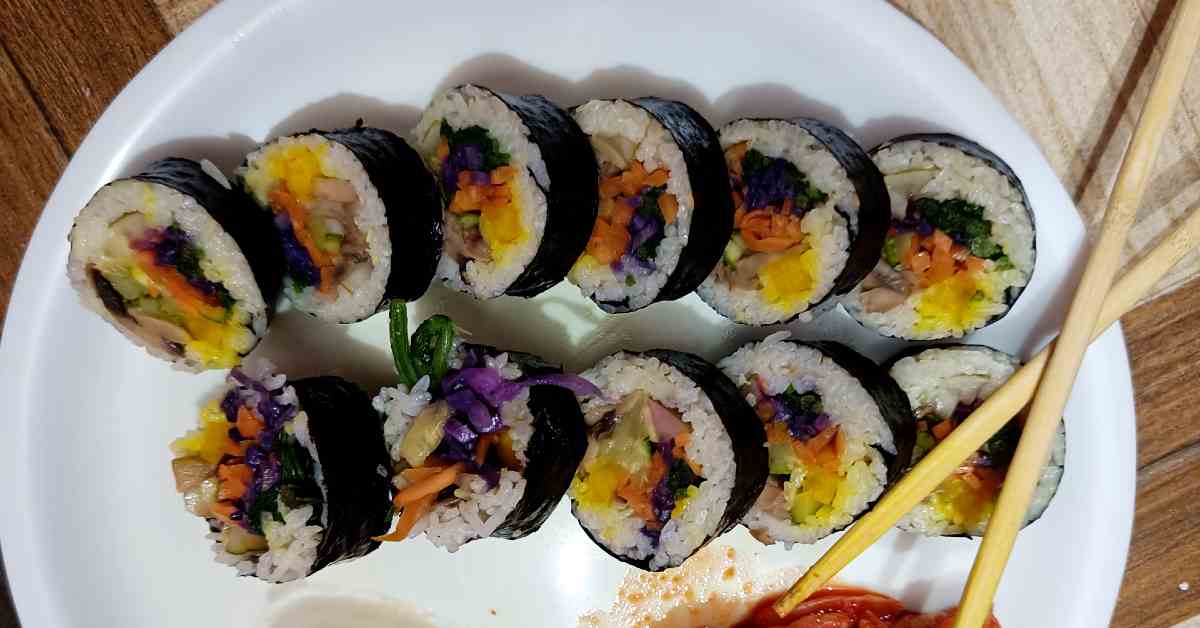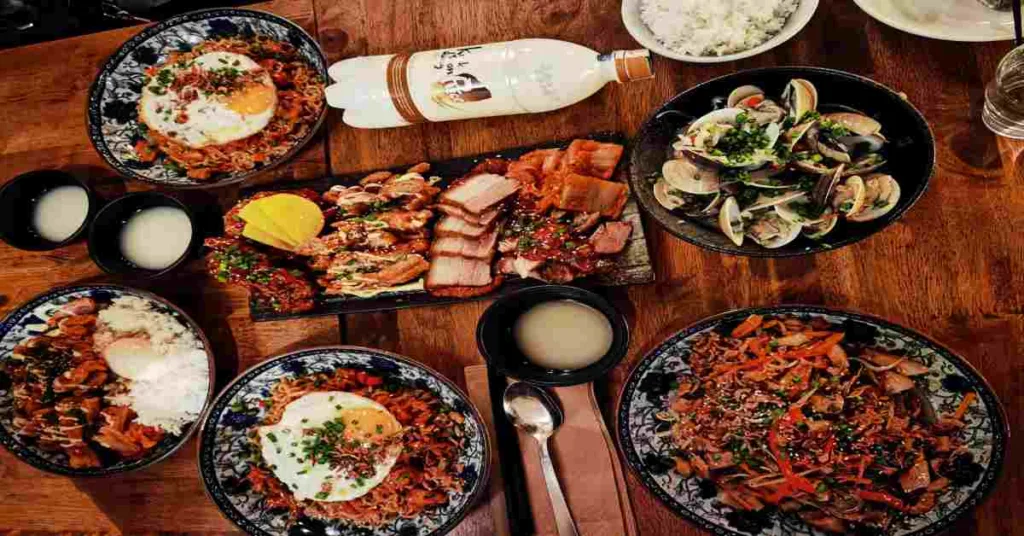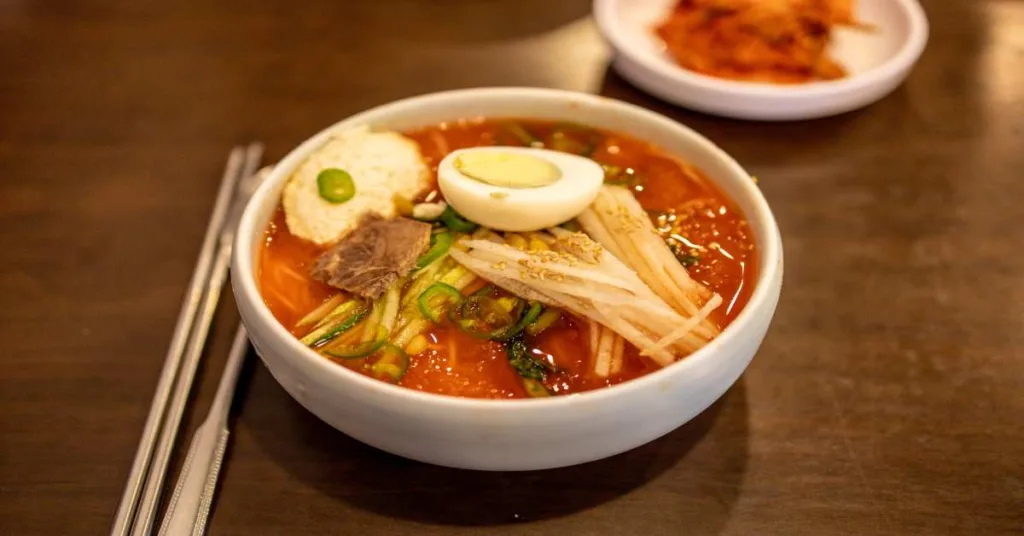Widely used grab-and-go Korean famous street food is known as Gimbap or Kimbap. Korean famous food Kimbap is the food that every Korean picnicker must have. This dish is produced by wrapping sushi rice, meat, spinach, and stir-fried veggies in seaweed. It seems too good to eat. Kimchi is placed on the side and the roll is then cut into tiny, bite-sized discs. At least, everyone should try it once.
Kimbap could seem like a time-consuming dish because of the multiple preparation processes each ingredient needs. But unlike what you may anticipate, the outcomes are pleasant. Additionally, it presents beautifully and has a fair price.
Content:
- What is Kimbap/Gimbap?
- Benefits of homemade Kimbap/Gimbap.
- Gimbap recipe.
- How to store Gimbap/Kimbap?
What is Gimbap/Kimbap?
Despite the fact that many people think Kimbap and Sushi may be similar, there is a significant difference between them in terms of the fillings and how the rice is used. While the rice in Japanese sushi is seasoned with vinegar and sugar, it is blended with sesame oil and salt in Korean kimbap. Even though it is frequently referred to as Korean sushi or a Korean sushi roll, we prefer to call kimbap by its Korean name, Gimbap.
White rice, a variety of vegetables, including spinach, pickled radish, carrot, egg, burdock, and others, are rolled up with dried seaweed to produce gimbap. The name of the gimbap is determined by the main filling. Other variants exist, such as cheese, kimchi, and meat gimbap.
Benefits of homemade Gimbap/Kimbap
It is really healthy to eat Gimbap. Making it at home allows you to incorporate components that adhere to your nutritional needs, such as vegan Gimbap. There are some benefits of Gimbap which are mentioned below:
- Fibre, carbs, vitamins, minerals, iodine (a trace element), and protein are all abundant in kimbap. Kimbap’s high fibre content can aid in satiety as well as digestive improvement and a reduction in colon transit time, both of which are important in preventing colon cancer.
- Kimbap has a lot of minerals in it as well. Mineral-rich kimbap is frequently referred to as a fantastic natural source. It is also considerably richer in calcium than other foods, as well as potassium, sodium, iron, copper, and iodine, all of which are important for maintaining healthy metabolisms.
- Numerous antioxidants, including vitamins and shielding pigments, can be found in kimbap.
- Kimbap contains vitamins A, B, C, and E. These vitamins are all essential for maintaining healthy health. Typically, meats are the main source of vitamin B12. Kimbap is one of the few vegetables that is an excellent source of B12, which is advantageous for vegans who abstain from all animal products.
- Kimbap has a very high level of protein. Two potent amino acids found in kimbap are aspartic and glutamic. These two amino acids contribute to the flavour of kimbap.
Gimbap recipe
Ingredients:
- For vegetables: spinach, carrot, cucumber, lettuce.
- For pickled vegetables: radish pickles, cucumber pickles, jalapeno pickles, and burdock roots.
- Other fillings: fishcakes, imitation crab meats, etc.
You can make your vegetarian or vegan depending on the items you use.
Recipe
Rice for kimbap must be either medium or short grain. Because the rice needs to have some stickiness to bind to the seaweed sheets, long-grain rice won’t work. To give your rice a nicer texture, you could cook it with a little less water than usual.
To prepare kimbap, you can season the rice in one of three ways;
- sesame oil and salt.
- vinegar, sesame oil, and sesame seeds.
- Korean plum extract (mail Chung) and salt.
Sesame oil and salt are the two most popular seasonings for rice.
Step 1: Season the Rice
Over freshly cooked rice, add 2 tbsp of Korean plum extract and a few pinches of salt. Toss well. When cooling, cover the rice with a kitchen towel.
Step 2: Prep the kimbap filling ingredients
Using pre-made radish pickles with burdock roots is simple and is available in Korean markets. To use them, make sure to thoroughly drain them.
- For egg: Beaten eggs should be cooked in a skillet over medium heat. Slice thinly after rolling them up.
- For Carrot: Shredded carrot is cooked in a skillet with a little salt and oil. To create steam, add 2 tbsp of water. Then, cover it with a lid. Cook till crisp but tender for 2 minutes.
- For Fishcake: Thinly slice the fishcake sheets and stir-fry for 1 minute over high heat in a little oil. In a small bowl, combine rice wine, soy sauce, and sugar. Add the mixture to the fishcake. Stir-fry for a further minute.
- For Spinach: In a pot of salted boiling water, blanch the spinach. Rinse with cold water after draining. Squeeze the extra water out. Add salt, sesame oil, and sesame seeds to a mixing bowl with the spinach and toss well.
Step 3: Spread Rice evenly
On a bamboo rolling mat, place a whole sheet of seaweed with the glossy side down and the longer side facing you. Spread 1/6 of a cup of rice evenly over the seaweed, leaving 1 inch at the end empty. In the centre of the rice, place a half-sheet of seaweed.
Step 4: Layer the filling
On top of the half seaweed sheet, arrange the filling ingredients in a pattern of contrasting colours.
Step 5: Roll the Gimbap
Beginners who have never rolled seaweed rice rolls before may find the process intimidating at first and may need some practice.
With both hands, lift the entire length of the mat away from your side. Then, turn over to cover the fillings and tuck them in with your fingers. As you roll the mat away, apply strong pressure to the roll and keep rolling until it reaches the end.
Step 6: Slice into an even thickness
The final kimbap should be uniformly thick. While you make another, put the seam side down on a dish. Use a sharp knife to slice into 1/2-inch-thick pieces. When putting rice on the seaweed, grease your fingers with a tiny bit of oil to prevent the rice from adhering to your hands.
- When slicing, use a brush to lightly grease the blade of your knife for the same purpose.
How to store?
On the day you make it, tastes the finest. Kimbap is suitable for a few hours at room temperature. However, if you leave them in the fridge for too long, they don’t taste as wonderful. Kimbap can be kept in the fridge for up to 3 days if you have any leftovers.
Know more about Korean famous food
https://worldviajar.com/category/blog/korean-food/


